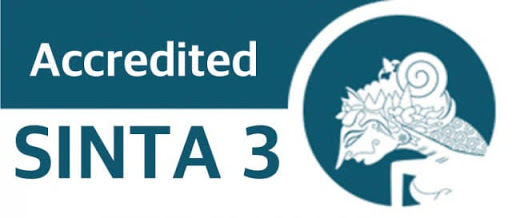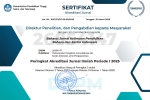Makna Kerinduan dalam Puisi Karya W.S. Rendra dan Medy Loekito
Abstract
The research analysis of comparative literary studies is motivated by two titles of poetry texts that have the same meaning, namely the poem "Kangen" by WS Rendra and the poem "Rindu" by Medy Loekito which are also objects in this comparative literary research. The purpose of this comparative study is to find out the difference in the meaning of longing from the two objects of the poem. In the analysis of the two poems, a comparative descriptive research method is used, which is carried out by collecting data and then performing a comparative analysis, namely determining the similarities, differences and relationships of the objects of comparative literary study. The results of this study are to show the meaning of the word longing and the word longing which actually has the same meaning, namely the desire to meet a loved one. In the two poetry texts there is relevance, namely feelings, because in both poems they express feelings of longing with different language styles.
Abstrak
Penelitian analisis kajian sastra bandingan ini dilatarbelakangi oleh dua judul naskah puisi yang memiliki kesamaan makna yakni puisi “Kangen” karya WS Rendra dan puisi “Rindu” karya Medy Loekito yang sekaligus menjadi objek dalam penelitian sastra bandingan ini. Tujuan dari kajian perbandingan ini adalah untuk mengetahui perbedaan makna kerinduan dari dua objek puisi tersebut. Dalam analisis kedua puisi tersebut menggunakan metode penelitian deskriptif komparatif yang dilakukan dengan cara mengumpulkan data kemudian melakukan penganalisisan perbandingan yaitu menentukan persamaan perbedaan maupun hubungan dari objek kajian sastra bandingan tersebut. Hasil dari penelitian ini adalah menunjukkan makna kata rindu dan kata kangen yang sebenarnya memiliki persamaan makna yaitu keinginan untuk bertemu dengan orang yang dicintai. Dalam kedua teks puisi tersebut terdapat relevansi yaitu perasaan, karena dalam kedua puisi tersebut mengungkap perasaan rindu dengan gaya bahasa yang berbeda.
Keywords
Full Text:
PDFReferences
(ELP), E. L. P. (n.d.). Kaera Language Metadata. Retrieved 2 June 2022 from e ndarangeredlanguage.com
Berlin, B. (1992). Ethnobiological Classification Principles of Categorization of Plants and Animals in Traditional Society. Princeton University Press.
https://doi.org/10.1515/9781400862597
Berlin, B. (2006). The first congress of ethnozoological nomenclature. Journal of the Royal Anthropological Institute, 12, S23-S44.
https://doi.org/10.1111/j.1467-9655.2006.00271.x
Ellen, R. (1993). The Cultural Relations of Classification: An Analysis of Nuaulu animal categories from central Seram (E. Gellner, J. Goody, S. Gudeman, M. Herzfeld, & J. Parry, Eds.). Cambridge University Press.
https://doi.org/10.1017/CBO9780511470530
Frake, C. O. (1961). The Diagnosis of Disease among the Subanun of Mindanao. American Anthropologist, 63(1), 113-132. http://www.jstor.org/stable/667341
https://doi.org/10.1525/aa.1961.63.1.02a00070
Hamill, J., Sidky, H., & Subedi, J. (2002). Birds for Words in Jirel: Structure and Function in a Tibeto-Burman Folk Taxonomy. Anthropological linguistics, 44(1), 65-84. https://go.exlibris.link/hl8Tljk6
Hengsuwan, M., & Prasithrathsint, A. (2014). A Folk Taxonomy of Terms for Ghosts and Spirits in Thai. MANUSYA, 17;2014;(2), 29-49. https://doi.org/10.1163/26659077-01702003
Kadarisman, A. E., & Williams, R. (2009). The "Language is a Mirror" metaphor and its implications on foreign language teaching. Mengurai Bahasa Menyibak Budaya, 172-198.
Klamer, M. (2016). Abangiwang Kaera field notes. https://lexirumah.model-ling.eu/sources/klamer16-kaera
Klamer, M. (2017). The Alor-Pantar languages: History and typology. Second edition. Language Science Press. https://doi.org/10.5281/zenodo.437098
Kutuzova, N. S. (2020). Semantical Meanings of Colours in Chinese Culture. In Proceeding of the International Science and Technology Conference "FarEastСon 2019" (pp. 445-453). Springer Singapore. https://doi.org/10.1007/978-981-15-2244-4_42
Leo, H. Y., Weking, C. T., Tamelab, B., & Puling, A. T. (2019). Kosakata Kaera-Indonesia. In Kosakata Kaera-Indonesia.
Mu'jizah, M. J., Firdaus, W., Suyatno, S., & Rohim, R. (2022). Digital Based Literature Learning Enhancement: Vista Sastra.
NTT, T. P. K. B. (2021). Kosakata Kaera-Indonesia (Edisi Revisi). In Kosakata Kaera-Indonesia (Edisi Revisi).
Phaka, F. M., Netherlands, E. C., Kruger, D. J., & Du Preez, L. H. (2019). Folk taxonomy and indigenous names for frogs in Zululand, South Africa. Journal of ethnobiology and ethnomedicine, 15(1), 1-8.
https://doi.org/10.1186/s13002-019-0294-3
Worojie, T. B., Asfaw, B. T., & Mengesha, W. A. (2021). Indigenous biosystematics of yams (Dioscorea spp.) in Southwest Ethiopia: folk taxonomy, ethnolinguistic analysis, and folk descriptors. Journal of ethnobiology and ethnomedicine, 17(1), 1-1. https://doi.org/10.1186/s13002-020-00427-8
DOI: https://doi.org/10.26499/bahasa.v4i2.125
Refbacks
- There are currently no refbacks.

This work is licensed under a Creative Commons Attribution-NonCommercial-ShareAlike 4.0 International License.
This work is licensed under a Creative Commons Attribution-ShareAlike 4.0 International License.
Apartemen Suite Metro
Jalan Soekarno Hatta No. 698B, Kelurahan Jatisari - Kecamatan Buahbatu Bandung, Jawa Barat 40286
























